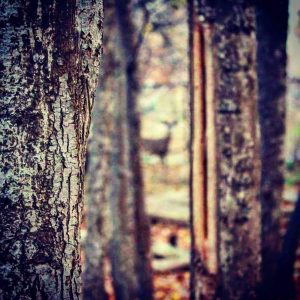Culling the deer at Point Pelee – it’s time to thin the herd

A deer can be seen hiding behind some trees in one of Essex County’s parks. Photo by: Laurie Harrison.
Sighting a deer at a national park is always a thrill, but often times, impossible.
As elusive as they are, Point Pelee National Park, in reality, is over-populated with deer.
“At our most recent count which happened in this past December, we were up to 103 individual in the park,” said Maria Papoulias, superintendent of Point Pelee National Park.
“Our goal is to get the deer population to about 30 deer. Which would be the number that could be reasonably sustained by the ecosystem here,” she said.
As part of an overall conservation plan for the forest and savannah ecosystems in Point Pelee, a number of things for restoration have been taking place, including: restoring the habitat for species at risk, planting native species and removing invasive species.
Removing deer from the ecosystem during their annual deer cull is part of this overall plan and will see the park closed until Jan. 26.
Park officials said the lack of intact forest cover is directly tied to the over-population of deer. There is a good reason why the deer number has grown so large.
“There aren’t any large natural predators of deer left because they don’t have enough area to support them, so natural predators like wolves and bears that would normally eat deer are not present in the ecosystem,” explained Papoulias. “The deer really thrive on agricultural lands, so their numbers grow out of control.”
“We found over about 30 years of research, that that is having an unacceptable effect in the plant life in the park and many of our species at risk and our ecosystems,” said Papoulias. “And again in 30 years of research, we found that culling the deer is the most effective way to control their numbers and is the closest thing to replicating natural predation.”
“Hunters are the best form of conservation there is,” said Dave Harrison, a local hunter. “These pretty little animals that they (people) care so much about wouldn’t even exist without hunters controlling the population because they would eat themselves out of a food source.”
Point Pelee National Park works with Caldwell First Nation closely, and all of the hunters are park staff or from Caldwell First Nation.
“It is highly unlikely we will get down from 103 to 30 in one year. Depending on the year, we have been able to remove anywhere between 30 and 70 deer, last year we only got 20 deer,” said Papoulias. “So we will continue to remove deer until the point where we have that number in the ecosystem.”
Why not just move them?
“Have you ever tried to catch a deer? It’s hard enough to shoot one with a gun that goes 1,400 feet per second, let alone catch one and then relocate it,” said Harrison.
Papoulias also said mortality rates for relocated deer are as high as 50 per cent in the first year because of a number of factors.
“It could have been stress or injury caused during the move or an inability to adapt to a new area that they were put into,” she said. “Imagine you were picked out of your home and dropped in an alien city. It is very hard for them to survive so they will suffer, they will starve, and they will die in a less humane manner than by hunting them in many cases.”


